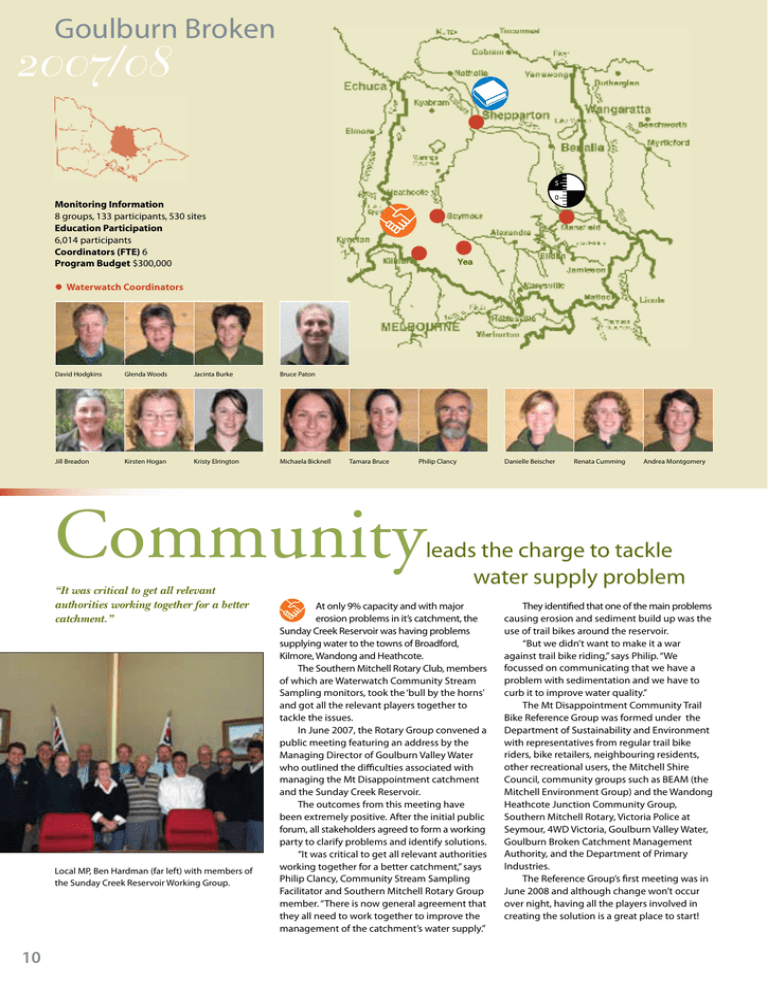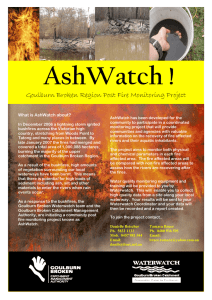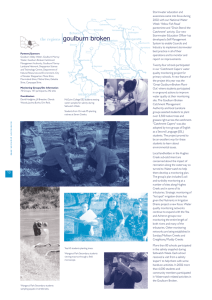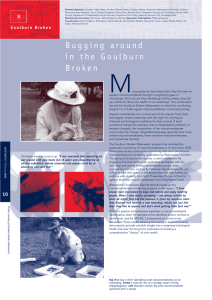2007/08 Goulburn Broken •
advertisement

Goulburn Broken 2007/08 Monitoring Information 8 groups, 133 participants, 530 sites Education Participation 6,014 participants Coordinators (FTE) 6 Program Budget $300,000 • Waterwatch Coordinators David Hodgkins Glenda Woods Jacinta Burke Bruce Paton Jill Breadon Kirsten Hogan Kristy Elrington Michaela Bicknell Tamara Bruce Philip Clancy Danielle Beischer Renata Cumming Andrea Montgomery Community “It was critical to get all relevant authorities working together for a better catchment.” Local MP, Ben Hardman (far left) with members of the Sunday Creek Reservoir Working Group. 10 leads the charge to tackle water supply problem At only 9% capacity and with major erosion problems in it’s catchment, the Sunday Creek Reservoir was having problems supplying water to the towns of Broadford, Kilmore, Wandong and Heathcote. The Southern Mitchell Rotary Club, members of which are Waterwatch Community Stream Sampling monitors, took the ‘bull by the horns’ and got all the relevant players together to tackle the issues. In June 2007, the Rotary Group convened a public meeting featuring an address by the Managing Director of Goulburn Valley Water who outlined the difficulties associated with managing the Mt Disappointment catchment and the Sunday Creek Reservoir. The outcomes from this meeting have been extremely positive. After the initial public forum, all stakeholders agreed to form a working party to clarify problems and identify solutions. “It was critical to get all relevant authorities working together for a better catchment,” says Philip Clancy, Community Stream Sampling Facilitator and Southern Mitchell Rotary Group member. “There is now general agreement that they all need to work together to improve the management of the catchment’s water supply.” They identified that one of the main problems causing erosion and sediment build up was the use of trail bikes around the reservoir. “But we didn’t want to make it a war against trail bike riding,” says Philip. “We focussed on communicating that we have a problem with sedimentation and we have to curb it to improve water quality.” The Mt Disappointment Community Trail Bike Reference Group was formed under the Department of Sustainability and Environment with representatives from regular trail bike riders, bike retailers, neighbouring residents, other recreational users, the Mitchell Shire Council, community groups such as BEAM (the Mitchell Environment Group) and the Wandong Heathcote Junction Community Group, Southern Mitchell Rotary, Victoria Police at Seymour, 4WD Victoria, Goulburn Valley Water, Goulburn Broken Catchment Management Authority, and the Department of Primary Industries. The Reference Group’s first meeting was in June 2008 and although change won’t occur over night, having all the players involved in creating the solution is a great place to start! Ashwatch: Recording recovery after bushfires The major bushfires that burnt for 69 days over the summer of 2006/07 created large volumes of ash and sediment, destined to be swept into waterways. Covering nearly 1.1 million hectares, the fires included 370,600 hectares in the Upper Goulburn catchment. In response, the Goulburn Broken Waterwatch team quickly jumped into action and set-up a major post-fire project they dubbed Ashwatch, aimed at monitoring the affects of the bushfires on waterways. Seven waterways in the Upper Goulburn catchment were identified and existing community monitors were called on to assist with extra monitoring at new sites. A call also went out for additional volunteers. All monitors received training on the correct use of testing equipment and instructions about the expanded monitoring program which included new testing parameters. The 12-month monitoring project started in April 2007 and data was collected fortnightly, and where possible, after rain events. Macroinvertebrate surveys were also undertaken in the affected waterways. “Some of the results have been pleasing,” says Tamara Bruce, Upper Goulburn Waterwatch Facilitator, “and others indicate that the waterways aren’t recovering as well as we had hoped.” “The Goulburn River above Jamieson has been the worst affected,” she says. Prior to the fires, Waterwatch had conducted macroinvertebrate surveying that discovered some significant species normally found in pristine waterways. “Unfortunately we haven’t found them again since the fires. On the other hand, the Delatite River has bounced back well.” Waterwatch shared its monitoring results with management agencies and the Goulburn Broken Catchment Management Authority has The Goulburn River upstream of Lake Eildon in July 2007 after the fires. “It is very pleasing that our data is being recognised and used by agencies like the CMA.” provided funding to continue the program for two more years. “It is very pleasing that our data is being recognised and used by agencies like the CMA,” says Tamara. “It gives our volunteer monitors validation, and motivation to keep recording the changes occurring in their rivers as a result of the fires.” learning Environmental - in the school holidays? Goulburn Broken’s new Junior Environmental Ambassadors after graduating from the 2007 Environmental Science Workshop. “We wanted to get students thinking about the environment and issues facing our society today.” Who would have thought kids would give up their precious holiday time to continue their education! Believe it or not, it happened in the Goulburn Broken region during the 2007 September holidays when 32 students participating in a three-day environmental science education workshop graduated as ‘Junior Environmental Ambassadors.’ Goulburn Broken Waterwatch organised the workshop for upper primary and lower secondary school students, which was free thanks to funding from the Goulburn Broken Catchment Management Authority’s Education Grants Scheme. The intensive program was also a great opportunity for students from larger schools, who don’t get as many hands-on environmental opportunities as students from smaller, rural schools. Students learnt about water treatment, quality and conservation, stormwater, global warming and biodiversity. The workshop was held at the Shepparton Science and Technology Centre with excursions to the local water treatment plant, Victoria Park Lake in Shepparton for an ‘environmental treasure hunt’ and to the Goulburn River for a bushwalk to observe the environment in action. Students had the chance to take part in science experiments, create artworks with recycled materials, plant trees and native grasses and help ‘Clean-up Australia’ along the banks of the river. According to Goulburn Broken Waterwatch Facilitator and workshop organiser, Michaela Bicknell, the idea was to bring a number of agencies together to present a range of environmental activities. “We wanted to get students thinking about the environment and issues facing our society today,” she says. “The students were curious and passionate. The workshop really raised their interest.” These new environmental ambassadors are already out spreading the sustainability message, with parents commenting on improvements in their children’s confidence and knowledge base in this important area of education. Partners and Sponsors of the Goulburn Broken Waterwatch Program Goulburn Broken Catchment Management Authority, Goulburn Valley Water, GoulburnMurray Water, Greater Shepparton City Council, Moira Shire, Mitchell Shire, Goulburn Murray Landcare Network, Bureau of Rural Sciences, Parks Victoria. 11





